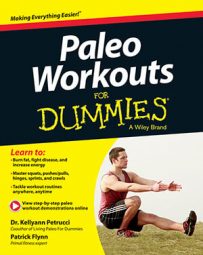The Turkish get-up is a primitive exercise that has you moving from just about every joint in your body, forcing you to stabilize where you need to stabilize and mobilize where you need to mobilize. Its primary purpose is to get you up off the ground safely.
Furthermore, this movement is the most comprehensive of all primal warm-ups. Five minutes of consecutive Turkish get-ups will prep the body for any and all rigors of vigorous exercise.
You can perform the Turkish get-up anywhere, anytime. To keep on the move and to reap the maximum benefit of this exercise, set yourself a daily Turkish get-up quota. Try working even just one unweighted Turkish get-up every hour you’re awake. You’ll be amazed at how refreshing it feels!
The Turkish get-up — or get-up for the sake of brevity — toughens the shoulders, hardens the abs, and loosens the hips through an exhibition of litheness. It’s a graceful movement with many nuances.
Don’t rush the get-up. In fact, the slower you go, the better. Take time to master each position and enjoy the ride.
A proper setup for the get-up is essential; an improper setup impedes the crusade downstream, which is to say that any get-up is only as good as any setup. Note: When first performing the get-up, don’t use any weight. After you’re proficient at the movement, you may then use a kettlebell (preferred), a dumbbell (second best), or a barbell (most awkward but doable).
Here are the steps for the Turkish get-up:
Start by lying on your back (prone position).
Your arms and legs should be fully extended and angled out away from your body at roughly 45 degrees. Your right arm should run parallel to your right leg and your left arm parallel to your left leg. Think of the bottom of a snow angle position.
Pick a side to start with, follow these steps, and refer to the figure to continue the setup:
To work the right side of your body, press your right arm directly up in line with your sternum (mid-chest) as if you’re performing a one-arm bench press.
Bend your right knee and plant your right heel relatively (not directly) close to your butt.
Note: To work on the left side, follow the steps with your left arm and left leg.
![[Credit: Photo courtesy of Rebekah Ulmer]](https://www.dummies.com/wp-content/uploads/410079.image0.jpg) Credit: Photo courtesy of Rebekah Ulmer
Credit: Photo courtesy of Rebekah Ulmer
Perform a roll by pushing hard into your planted heel, pulling hard from your planted elbow, driving your chest upward, and propping yourself up onto your planted forearm.
![[Credit: Photo courtesy of Rebekah Ulmer]](https://www.dummies.com/wp-content/uploads/410080.image1.jpg) Credit: Photo courtesy of Rebekah Ulmer
Credit: Photo courtesy of Rebekah UlmerKeep your other arm extended straight overhead (imagine you’re balancing a half cup of water on your fist at all times — don’t let it spill!).
This step is to be a roll, not a crunch or a sit-up. If you lead with your head and round your back, then you’re doing it wrong. Lead with a proud chest, and keep your back flat.
Move from your forearm up to your hand by extending the elbow (see part b of the figure).
Don’t lift your hand to do this step; instead, simply pivot on it. An effective, but somewhat crude, cue is to pretend you’re squishing a beetle. Also, don’t let your shoulders shrug up in this position. Keep as much distance between your shoulders and ears as possible.
Complete a bridge by pushing your heel into the ground, squeezing your butt, and driving your hips up into the air.
![[Credit: Photo courtesy of Rebekah Ulmer]](https://www.dummies.com/wp-content/uploads/410081.image2.jpg) Credit: Photo courtesy of Rebekah Ulmer
Credit: Photo courtesy of Rebekah UlmerTry your very best to come into a full bridge, but don’t overextend. You should be able to freely lift your straight leg off the ground in the bridge position. If you can’t, you need to shift your weight onto the heel of your bent leg.
Sweep your straight leg back under your hips, planting your knee directly in line with your planted hand.
When done right, your legs should form an L with one knee facing forward and the other knee facing outward.
Don’t try to sweep your leg back in such a manner that both knees face forward, like they would in a lunge position. Doing so feels awkward and will put you into a bad position.
Simultaneously lift your planted hand and rotate your back leg to come up off the ground and into an overhead lunge position.
![[Credit: Photo courtesy of Rebekah Ulmer]](https://www.dummies.com/wp-content/uploads/410082.image3.jpg) Credit: Photo courtesy of Rebekah Ulmer
Credit: Photo courtesy of Rebekah UlmerThe movement of your back leg should look similar to a windshield wiper as your back calf swings outward until both knees are pointed in the same direction.
Stand up out of the lunge, as shown in part b.
Note that in the lunge position (Step 7), you want your back toes to be firmly planted on the ground (not pointed behind you) so you can push off your back leg just as much as your front leg to stand up.
Reverse everything you just did — step by step — and return to the starting position.
Practice the get-up as often as you can and get comfortable with it because you’ll use it in other movements used in Paleo Fitness. Eventually, you’ll load the get-up and execute it with a considerable amount of weight overhead, enhancing your strength, stability, mobility, and coordination.

